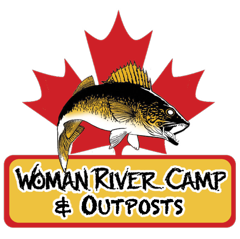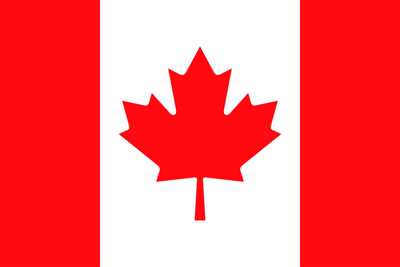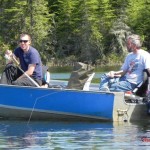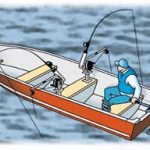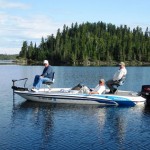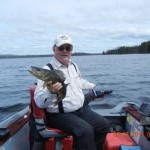Boat Control is essential to put more fish in the boat! There are a few different techniques to keeping your boat positioned over productive fishing waters. Most Northwestern Ontario Fishing Camps like Woman River Camp utilize most of these techniques. The most important one to become proficient at would be back trolling. At some point during your trip, you will need to back troll. A portage lake where you aren’t hauling an electric trolling motor and windy days would be the most common. Learning different methods to control the boat will make you a better fisherman and thus boat more fish!
There are numerous ways to control what a boat does while you are fishing.
- Drifting
- Anchoring
- Forward Trolling
- Use of an electric trolling motor
- Back Trolling
Lots of anglers pull up on a spot, cut the engine and start drifting, either with the current or have the wind push them along. This is a great way to fish. When your drift is over, fire up the engine and motor back up to start another drift. Sometimes it is beneficial to have the motor running all the time or have an electric trolling motor on the boat to make adjustments during your drift. You can also use the outboard motor to make minute adjustments when it isn’t even running by just turning the motor. Different size boats will drift at different speeds depending on their weight and how much of the boat catches the wind. Drift socks can also be used to slow a drift down on windy days.
Anchoring
Anchoring is a good way to control the boat. Especially for the captain. But it’s not as simple as just dropping the anchor over the side and wrapping the rope around a cleat. The right ratio of rope to depth of the water will help ensure the anchor holds in place. Usually a ratio of 8:1 works the best. Before anchoring, mark the spot you would like the boat to be positioned when anchored. Then pull up 3x as far and drift back to see if you hit the spot. If you don’t, try it again from a different starting point. When you finally go over the fishing hole, that was the starting point where you should drop anchor. You can use either one anchor off the bow or add a second smaller anchor near the stern to prevent the boat from moving. NEVER anchor only from the stern. It can be very dangerous with waves coming over the back of the boat. Don’t anchor in the middle of a channel where other boats need to travel. It is also a good idea to have a sharp knife handy just encase you need to cut the rope to free the boat in an emergency. Anchoring is a great way to relieve the captain of boat control but a pain when the fish move and you need to set the anchor all over again. Can also be a good upper body workout.
Forward trolling is great when covering area over deeper water, or when a faster speed is required. The use of longer fishing rods really helps when forward trolling. Using 10 to 14 ft fishing rods will allow anglers in the front of the boat to keep their fishing lines away from the motor when the boat is turning. This is critical to spend more time fishing than untangling lines from around the prop. Forward trolling is great when long lining for Trout or downrigging. Use the throttle to continuously change speeds to entice fish to strike. Be careful when trolling close to shallow structure like shorelines and reefs. When the wind blows the bow of the boat towards the shallows and the captain has to give it throttle to straighten it out, the motor will move lower in the water and can hit bottom causing damage to the prop.
Electric trolling motors on the bow or stern of the boat can be very handy to troll with. Units these days can keep you at a specific depth and anchor you in a spot along with many other great features. They are also quiet. While that isn’t quite as important these days with the advancement of 4 stroke outboards and how quiet they run. Electric trolling motors tend to have lower costs if you smash a prop on rocks. No worries about clogging water intakes when going through weedbeds. They are really beneficial when there is little wind or it is calm. Just be sure to have a fully charged battery. If you have to run it on high all the time, it may be better to use the outboard.
Up here in Northwestern Ontario, where most camp boats are all tiller outboards, back trolling is the way to go for boat control. Whether you are at a remote boat in outpost, portage lake or one of many tourist camps like Woman River Camp, you won’t always have an electric trolling motor or an anchor to use. It is best to become proficient at back trolling. Simply point the stern of your boat into the wind and put the motor into reverse gear. If you are moving too fast, occasionally put the motor in neutral and back into reverse. In a stronger wind, throttle up and use the throttle lock to keep the boat in position. The stern itself will slow the boat down compared to a forward troll when the bow breaks the water. When fishing shoreline, be sure to start your back troll with the port (left) side of the boat away from shore. The bow will be pushed towards the shore and everyone can fish off the port side keeping lines out from under the boat. Don’t worry about backing into underwater structure. The captain can be looking down below the motor and see rocks coming. Either steer around the rock or put the motor into neutral. Bumping a rock with the motor isn’t the end of the world and you won’t damage anything in neutral at a slow speed. You will be amazed how easy it is to keep the boat going the direction you would like or to hold in place. My motor rarely shuts off during the day. It doesn’t seem to spook the fish either. There will be days when the waves are splashing over the back of the boat but that is what rain suits are for. Learning to back troll with a tiller outboard is key tool to consistently catch fish in Northwestern Ontario.
Boat control is a very important part of consistently catching fish. Whether you are Walleye fishing or casting for Northern Pike and Bass, 90% of the fish are in 10% of the water and you need to be able to properly put your presentation in front of the fish. Learning how to maneuver your boat while fishing is essential. Take advantage of our boat control lessons at Woman River Camp and become a better boat operator. Put more fish in your boat!
